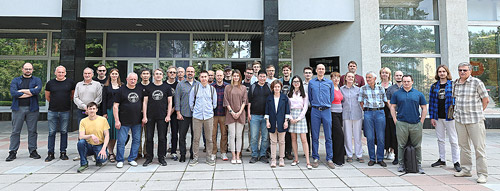
Electronic english version since 2022 |
The newspaper was founded in November 1957
| |
Meetings
Results of the expedition, scientific results,
prospects for the development of the facility
On 3 - 6 June, the Summer Workshop of the Baikal-GVD Collaboration was held at the JINR International Conference Centre. About 60 physicists, engineers, programmers and specialist engineers gathered to discuss the results of this year's winter expedition, to talk about the current state of affairs and to draw up a plan for the development of the project in the short-term and long-term prospects.
The new Head of the Baikal-GVD Collaboration, Head of the High Energy Neutrino Astrophysics Laboratory INR RAS Zhan-Arys Dzhilkibaev opened the meeting. Afterwards, DLNP Director Evgeny Yakushev addressed the scientists and specialists with a welcoming speech. He announced the acquisition of a land plot by the Institute on the shores of Lake Baikal for the construction of a new expeditionary town, the construction of which will start this year.
The first three days of the meeting were dedicated to the work of individual sections. Issues related to the current state of the facility, data quality analysis, acoustic and inertial positioning system data, spatial and time calibration of the telescope were discussed at the primary data processing section.
The results of monitoring of the hydro-optic properties of the water, an online monitoring system for the vertical distribution of the temperature of the water column of the lake were presented at the section on the investigation of the aquatic environment of the lake. In order to correctly interpret the data obtained, it is critically important for scientists to know the properties of the Baikal water and the changes taking place in it, to track them over time.
This winter, our Chinese colleagues installed their experimental garland with optical modules developed in China on Lake Baikal. At the Workshop, they talked about the conclusions made after the expedition and the first results of data processing.
The members of the Collaboration talked about the electronics of the telescope: about preparing equipment for expeditions, about assembly and repair, about studying the response characteristics of optical modules. Several reports were dedicated to the prototype of a new generation telescope: development options and the design of a new type of electronics. To significantly increase the detection sensitivity, optical modules of a new configuration will be developed and advanced data acquisition systems will be used.
At the section of astrophysical analysis and reconstruction of events, the results obtained were considered, the search for galactic neutrinos and the determination of the diffuse flux of cosmic neutrinos were discussed.
The plenary part ended with reports by the specialists from the Monte Carlo simulation sections and technical work at the Onshore Hospital in Baikalsk. The meeting of the Collaboration Committee followed the Workshop.
A senior researcher at DLNP, a member of the Baikal-GVD Collaboration Bair Shaibonov said, "We observe a phased development of the experiment: the focus increasingly shifts towards astrophysical data analysis. Previously, we mainly discussed the deployment of the facility, that is, technical issues.
We grow up and strive to get good physical results. It is happening right now and there were reports on this topic at the meeting. We can state the report of Zhan-Arys Magisovich Dzhilkibaev on the limit set on the flux of ultrahigh-energy neutrinos.
At the world level, it is relevant and due to the fact that CM3NeT has registered neutrino events of ultra-high energies and this is our contribution to the international piggy bank. A new diffuse flow result was presented. The obtained result was observed at the level of 5 sigma that indicates the observation of a diffuse flux of astrophysical neutrinos. Moreover, we obtained the parameters of the value of the absolute flux and its indicator of the spectrum."
Head of the Baikal-GVD facility, the head of expeditions Igor Belolaptikov emphasized "We summed up the results of this year's winter expedition: despite the difficult ice conditions, most of the scheduled work on the deployment of the unit and its modernization was completed. According to the analysis of expeditionary work, positions were highlighted where optimization could be carried out and the efficiency of telescope deployment increased.
At the meeting, new results of data processing over the past period and possible extensions of operational data analysis were presented that is important both for monitoring the operation of the facility and for the tasks of comparing observations from different facilities online. It was also about the prospects for the development of the facility, about the possibilities of expanding the experimental cluster to the prototype of the next generation neutrino telescope."
As reported by the DLNP Scientific Communications Group,
photo by Igor LAPENKO
